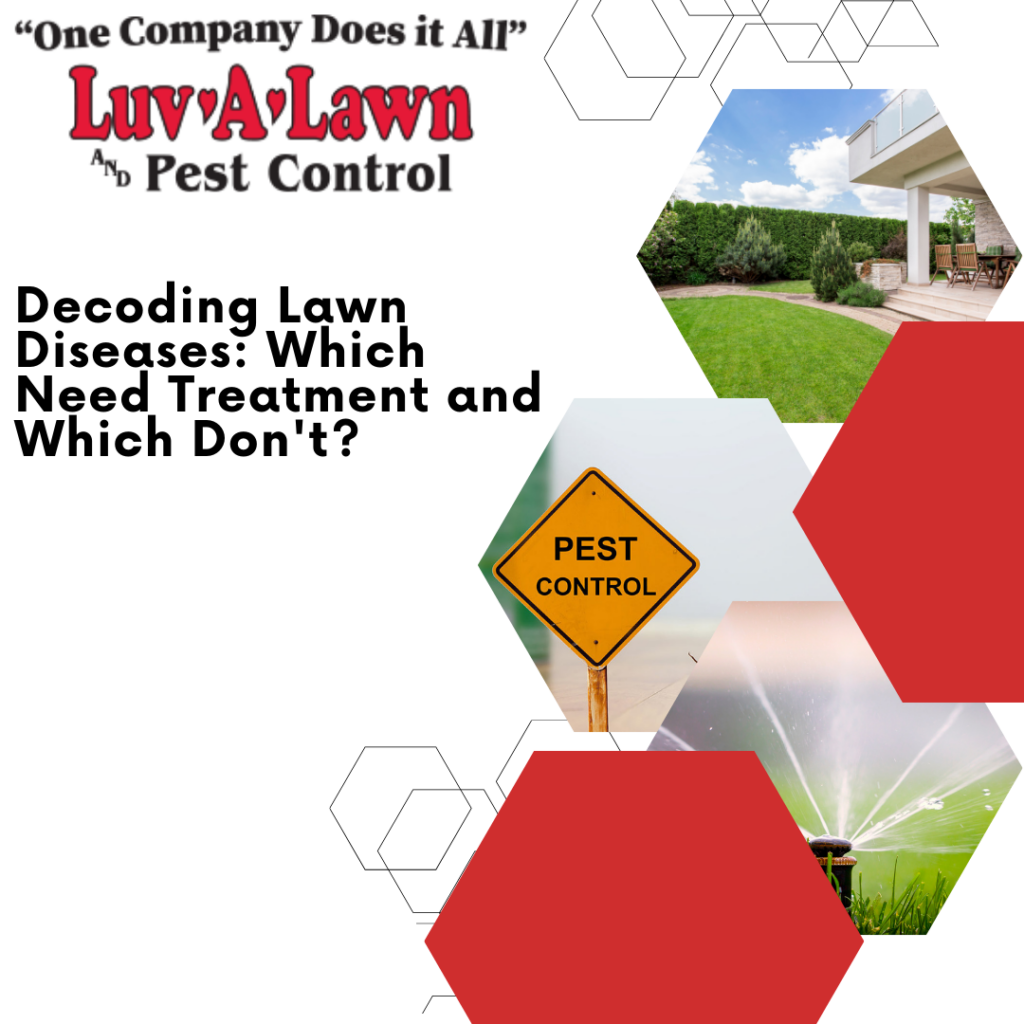
Decoding Lawn Diseases: Treatment Options & Prevention Tips
Decoding Lawn Diseases : Treatment Options & Prevention Tips
Lawn Diseases - As a homeowner, maintaining a healthy, lush green lawn is both a priority and a source of pride. However, lawn diseases can make this goal more challenging, leading to unsightly brown spots, weakened grass, or rapid deterioration of your yard. Understanding how to identify common lawn diseases, determine which ones need treatment, and implement preventive measures can save you time, effort, and money in the long run.
At LuvALawn, we provide full-service pest control solutions - including indoor and outdoor pest management and pest-controlled irrigation systems - to effectively address and prevent lawn diseases. In this extensive article, we will dive into the world of lawn diseases, decoding their symptoms and causes and helping you learn which ones require treatment and which don't. Additionally, we will share essential preventive and maintenance tips to maintain your lawn's health and prevent future outbreaks.
With our expert guidance, you will not only have greater knowledge of the complex world of lawn diseases but also become a well-informed homeowner capable of making smart decisions for your yard's wellness. So, join us as we explore lawn diseases and uncover their mysteries, arming you with the knowledge and tools necessary to maintain a healthy, vibrant lawn.
Recognizing Common Lawn Diseases
Successfully managing lawn diseases begins with identification. Familiarizing yourself with the symptoms and causes of common lawn diseases can facilitate early detection and intervention, limiting the damage to your yard. Here are four lawn diseases that frequently occur in American lawns:
- Brown Patch: Appearing as irregularly shaped brown spots with a greyish border, brown patch is a fungal disease caused by the pathogen Rhizoctonia solani. This disease is common in warm-season grasses like St. Augustine and can be triggered by high humidity and temperatures above 80°F.
- Dollar Spot: Dollar spot is characterized by small, straw-colored circular spots roughly the size of silver dollars. This fungal disease, caused by the pathogen Sclerotinia homeocarpa, affects many turfgrass species and is most active during periods of warm days and cool nights.
- Fairy Ring: Fairy ring manifests as dark green circles or arcs of grass with mushrooms or puffballs sometimes appearing on the perimeter. Caused by various fungi, this disease affects both warm-season and cool-season grasses. While not directly harmful to the grass, fairy rings can cause unsightly and uneven growth.
Deciding Which Lawn Diseases Require Treatment
Not all lawn diseases require immediate treatment. In some cases, the disease may resolve itself without intervention, while in others, preventive measures and proper lawn care are sufficient to keep the issue under control. However, for more aggressive or widespread lawn diseases, immediate treatment may be necessary to prevent severe damage.
- Brown Patch: Treatment is necessary if the infection is aggressive or spreads rapidly. Fungicides containing thiophanate-methyl or azoxystrobin can be effective, but it is crucial to avoid overwatering and provide proper fertilization to prevent future outbreaks.
- Dollar Spot: Treatment may not be required if the problem is minor and localized - proper mowing, watering, and fertilization can often resolve the issue. For more severe infections, applying a fungicide containing propiconazole or chlorothalonil may be necessary.
- Fairy Ring: If the fairy ring is not causing significant aesthetic issues or impeding turf health, treatment may not be necessary. However, if the problem is severe, aeration, irrigation, and applying a nitrogen-rich fertilizer can help control the disease.
Preventive Measures for Lawn Health
Preventing lawn diseases is an essential aspect of overall lawn care and maintenance. Implementing these preventive measures can reduce the risk of lawn disease outbreaks while promoting a healthy, vibrant yard:
- Mowing: Mow your lawn regularly at the recommended height for your grass species. Cutting too short can cause stress to the grass, leaving it susceptible to diseases. Make sure your mower blade is sharp, as a dull blade can cause grass damage.
- Watering: Water your lawn deeply but infrequently to encourage deep root growth. Opt for early morning watering to allow the grass blades to dry throughout the day, reducing the risk of fungal diseases.
- Fertility Management: Regularly test your soil to ensure it has the proper nutrient balance. Applying too much or too little fertilizer can weaken your lawn, creating conditions conducive to disease development.
- Aeration: Aerate your lawn regularly to promote healthy root systems, improve nutrient uptake, and alleviate soil compaction that can lead to disease.
- Monitoring: Regularly inspect your lawn for early signs of disease and pests. Promptly address minor issues before they escalate to extensive lawn damage.
When to Consult a Professional Lawn Care Provider
While many lawn diseases can be managed or prevented with proper care, you may encounter situations that require professional assistance. Some notable instances include:
- Persistent or Severe Disease: If you've tried all preventive measures and treatments, but the lawn disease continues to progress, or returns season after season, it's time to consult a professional lawn care provider like LuvALawn.
- Uncertain Diagnosis: If you're unsure of the type of lawn disease or how to treat it, it's best to enlist the help of a professional to ensure proper diagnosis and treatment.
- Large-Scale Issues: If the lawn disease has spread across a significant portion of your yard, it may be challenging to address the issue yourself. Professional lawn care providers have the expertise and resources to manage large-scale lawn disease outbreaks effectively.
Turning to a professional lawn care provider like LuvALawn can help you effectively manage lawn diseases and restore your yard's health. With expert services, tailored solutions, and a commitment to environmentally responsible practices, you can trust LuvALawn to safeguard your yard against diseases and pests, ensuring a healthy, lush landscape for years to come.
Lawn Diseases Specific to Florida and Warm-Climate Regions
Florida and other warm-climate regions face several unique lawn diseases due to the region's high humidity, frequent rain, and warm temperatures. As a Florida homeowner, you should be aware of the following lawn diseases that can affect your property:
- Take-All Root Rot: Also known as Take-All Patch, this lawn disease is caused by the fungus Gaeumannomyces graminis. It affects both warm and cool-season grasses, causing darkened roots and irregular dead patches. Proper mowing, watering, and balancing soil nutrients may help mitigate this disease.
- Gray Leaf Spot: Gray leaf spot, caused by the fungus Pyricularia grisea, targets warm-season grasses like St. Augustine and Bahia grass. It presents as tiny, grey, or brown patches on the leaves and spreads rapidly if left untreated. Timely fungicide application can help manage this disease in severe cases.
- Pythium: Pythium is an aggressive soilborne fungus that affects warm-season turfgrasses. It often causes thinning, yellowing, and wilting in the affected areas. When conditions are favorable (excessive rain, high humidity), it can spread quickly and cause significant damage to the lawn.
- St. Augustine Decline (SAD): Particularly affecting St. Augustine grass, SAD is caused by a virus transmitted by castor bean plants. The grass becomes stunted, thin, and discolored, eventually dying off. Planting SAD-resistant St. Augustine cultivars can help prevent this disease.
Best Practices for Water Management in Disease Prevention
Proper water management is crucial in preventing lawn diseases in warm climates. By following best practices for irrigation and water conservation, you can protect your lawn from unnecessary stress, allowing it to better fend off diseases.
- Choose the Right Time to Water: Water your lawn early in the morning (4 AM - 9 AM) to reduce water loss due to evaporation and to decrease the length of time the grass blades are wet. Longer wetness periods can promote fungal growth.
- Deep, Infrequent Watering: Instead of watering every day, water deeply and infrequently. Aim for 1 - 1.5 inches of water per week, which allows the water to reach the root zone while encouraging deep root growth.
- Water Conservation: Install water-saving technologies like rain sensors and smart irrigation controllers to efficiently water your lawn. These devices can help save water while maintaining optimal turf health.
- Regular System Inspections: Check your irrigation system regularly for leaks, clogs, or broken parts that can impact the effectiveness of your water management. Regular maintenance and repair can prevent overwatering or underwatering, both of which can contribute to lawn diseases.
Addressing Lawn Diseases Through Soil Management
Healthy soil is essential for a resilient, disease-resistant lawn. Soil management practices can help improve soil quality, promote turfgrass health, and prevent lawn diseases.
- Soil pH: Monitor your soil's pH level, aiming to maintain a pH between 6.0 and 6.5. Soil pH outside this range can restrict nutrient availability, making your grass more susceptible to disease.
- Soil Nutrient Balance: Regularly testing your soil can reveal nutrient imbalances that may contribute to lawn diseases. If needed, consult a professional for guidance on appropriate soil amendments.
- Organic Soil Amendments: Adding organic soil amendments like compost can improve soil structure, stimulate biological activity, and promote healthy grass roots.
- Reducing Soil Compaction: Aerate your lawn to relieve soil compaction. Compacted soil restricts root growth and oxygen availability, leading to a less resilient, disease-prone lawn.
Developing a Turfgrass Species Selection Strategy
Choosing the right turfgrass species for your climate, region, and specific property conditions can significantly impact your lawn's health and resistance to diseases. Follow these tips for a strategic species selection:
- Climate Suitability: In warm climates like Florida, consider using warm-season grass species like St. Augustine, zoysia, or Bermuda grass that have better tolerance for heat, humidity, and disease.
- Pest Resistance: Choose grass varieties with natural resistance to common pests and diseases for your region. Research the disease susceptibility of specific grass species and consult with local experts for recommendations.
- Sunlight and Shade Tolerance: Select grass species that can thrive in your yard's specific sun and shade conditions. Planting a grass type that fares poorly in your lawn's light conditions may lead to increased susceptibility to diseases.
- Tolerance to Site Conditions: Consider your lawn's other site-specific factors, such as drainage, foot traffic, salt tolerance, and soil type, when selecting turfgrass species. Choosing a grass type that is well-suited for your site conditions improves overall turfgrass health, reducing the chance of disease outbreaks.
Achieve a Healthy, Disease-Free Lawn with LuvALawn
A healthy, vibrant lawn enhances your property's aesthetic appeal, increases its value, and provides environmental and personal health benefits. By employing the comprehensive strategies discussed in this article—from proper water and soil management to proactive pest control and continual education—Florida homeowners can effectively tackle lawn diseases, ensuring a resilient and flourishing outdoor space.
However, when lawn management becomes overwhelming or when unique challenges require expert intervention, consider partnering with a professional lawn care provider like LuvALawn. Our team of experts at LuvALawn is here to help you combat lawn diseases and preserve the health and beauty of your landscape. With our comprehensive array of lawn care services—tailored to your specific property needs—we will provide you with environmentally responsible solutions for enduring turf vitality.
Don't let lawn diseases damage your valuable green space. Get started on building a resilient, disease-free lawn today. Reach out to LuvALawn to discuss your lawn care needs and learn how we can maximize your yard's potential. Together, we can create a thriving outdoor environment you will be proud to call your own.
It's time to love your lawn and create an outdoor sanctuary where you, your family, and nature can coexist and flourish.
